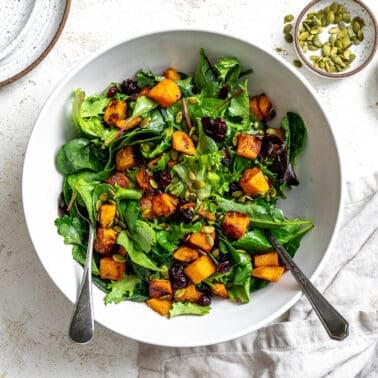As an Amazon Associate I earn from qualifying purchases.
Sautéed Swiss chard with garlic is a quick, easy, nutrient-dense side dish loaded with flavor and ready in 15-20 minutes!
![completed Sautéed Swiss Chard [with Garlic] plated on a white plate](https://plantbasedonabudget.com/wp-content/uploads/2023/12/Sauteed-Ruby-Chard-Plant-Based-on-a-Budget-10.jpg)
Table of contents
What is Swiss Chard?
Swiss chard is a leafy green vegetable known for its varieties with bright yellow, orange, and red stems and veins (often sold together as ‘rainbow chard’). It’s in the same family as beets and shares many of the properties of beet greens, with a texture somewhere between spinach and kale.
When raw, the leaves are earthy and slightly bitter but become wonderfully tender and mild when cooked – similar to spinach and other leafy greens. Plus, the stems are edible, too! It’s also packed with fiber and several vitamins and minerals, like vitamins A, K, and C, iron, magnesium, manganese, and copper.
Fun fact: Swiss chard is actually named after the Swiss botanist who discovered and gave the plant its scientific name, not because it’s from Switzerland.
Tender and Versatile Garlic Sautéed Swiss Chard
Whether you’re a Swiss chard lover or have no idea where to begin with this leafy green, this garlicky sauteed Swiss chard recipe is truly one of, if not the easiest of easy Swiss chard recipes.
It’s low in calories, packed with nutrients, simple to prepare in under 20 minutes with just one pan, and a versatile vegan side dish you can pair with practically any meal.
The Ingredients
This easy Swiss chard recipe relies on just 5 ingredients, including the cooking oil.
![ingredients for Sautéed Swiss Chard [with Garlic] on a white surface](https://plantbasedonabudget.com/wp-content/uploads/2023/12/Sauteed-Ruby-Chard-Ingredients.png)
- Swiss chard: Look for firm, glossy, blemish-free leaves and sturdy stalks (no wilting leaves or floppy stems).
- Garlic: Use fresh garlic for the best flavor.
- Onion: Use a white or yellow onion. When sautéed, its sweetness balances the earthy chard flavor wonderfully. Milder shallot or leeks work well, too.
- Neutral oil: We love using heart-healthy olive oil, though other cooking oils like avocado oil will work, too.
- Garlic salt: For even more pronounced, savory garlic Swiss chard. However, feel free to use regular sea salt if preferred.
Seasoning Variations
There are plenty of ways to add extra flavor and texture to this simple recipe for Swiss chard.
- Vegan butter (stir in a little just before serving for extra rich, buttery flavor)
- Red pepper flakes (or cayenne pepper – for some spiciness)
- Nutmeg (just a little for complementary flavor depth)
- Lemon juice (+ optional zest- added when serving for brightness)
- Balsamic vinegar (same as the above, but a different tangy flavor)
- Nutritional yeast (or vegan parmesan)
- Vegan feta cheese (to crumble over the top for creamy, salty, tangy flavor)
- Dried fruit (e.g., raisins, dried cranberries, or currants)
- Toasted almonds or sunflower seeds (for a toasty nutty flavor and added crunch)
- Vegan cream/canned coconut milk (add a few tablespoons at the end with some nutritional yeast/vegan parmesan for delicious creamy Swiss chard)
- Protein (like vegan sausage or vegan bacon/ tofu bacon)
How to Make Sautéed Swiss Chard with Garlic
- First, thoroughly rinse (they can contain dirt/soil), dry, and roughly chop the Swiss chard leaves, stems included. Then, peel and dice the onion and mince the garlic.
An easy way to prepare Swiss chard to sauté is to chop the stems separately (into ¼-inch slices), then roll up the leaves and slice them into strips (about 1 inch wide).
- Meanwhile, preheat a large skillet over medium heat with the oil.
- Once hot, sauté the onion and garlic for several minutes until the onion becomes translucent.

If you’re using lots of chard stems, add the stems to the pan with the garlic, as they take longer to soften. It can help to add a splash of water.
- Then add the Swiss chard and sauté until tender – about 3-5 minutes.

- Finally, season the sauteed chard with garlic salt to taste (start with about ¼ teaspoon and increase to taste), mixing well. Then serve and enjoy!


![process shot of Sautéed Swiss Chard [with Garlic] cooking in pan](https://plantbasedonabudget.com/wp-content/uploads/2023/12/Step-5-12-768x1024.png)
Recipe Pro Tips
- Cooking the chard stems: It’s best to sauté the lower stems at the same time as the onion, as they take longer to become tender.
- For an oil-free sauteed chard recipe: Use water or vegetable broth (about ¼ cup).
- Avoid overcrowding the pan: So the chard can sauté evenly.
- Be careful not to overcook it: The best sauteed Swiss chard should be tender but with a slight bite. Overcooked chard can become mushy.
- Experiment with flavors: There are several delicious, complementary seasonings and toppings you can enjoy with garlicky Swiss chard (some listed above).
FAQs
Several types of leafy greens would work as a great substitute for Swiss chard, including kale, spinach, collard greens, beet greens, and mustard greens. Bok choy or napa cabbage/green cabbage would also work.
Swiss chard is a nutrient-dense leafy green that you can enjoy raw or cooked – such as in salads and sandwiches/wraps, sautéed, braised, and added to soups. Milder baby chard is the best option for raw usage, though.
Just note cooking Swiss chard reduces the oxalic acid content, making it more nutrient-dense with nutrients that are more easily absorbed by our bodies.
Yes, the whole plant is edible, though the leaves will take slightly longer to cook. For that reason, you might prefer sauteing the stems for an extra 2-3 minutes before adding the leaves to the pan.
When raw, chard is earthy and somewhat bitter (though not as much as Kale) – with ruby chard and rhubarb chard having the strongest flavors and baby chard having the mildest.
When cooked, chard’s flavor becomes milder, slightly sweeter, and its texture is tender – more similar to spinach. In fact, blanching or sautéing Swiss chard is the best way to remove its bitterness. Especially when paired with strong flavors like garlic (and lemon/vegan cheese/vinegar).
![completed Sautéed Swiss Chard [with Garlic] plated on a white plate](https://plantbasedonabudget.com/wp-content/uploads/2023/12/Sauteed-Ruby-Chard-Plant-Based-on-a-Budget-7.jpg)
Storage Instructions
Leave the sauteed Swiss chard to cool, then store any leftovers in an airtight container in the refrigerator for 3-4 days.
Technically, you can freeze the Swiss chard for up to 3 months, too, though it can become mushy upon thawing.
Reheat it either in a microwave or on the stovetop. It will soften further.
![completed Sautéed Swiss Chard [with Garlic] in a storage container](https://plantbasedonabudget.com/wp-content/uploads/2023/12/Sauteed-Ruby-Chard-Plant-Based-on-a-Budget-14.jpg)
What to Serve With Garlic Sauteed Chard?
This simple dish of Swiss chard sauteed with garlic is a nutritious, versatile side dish you can use for any meal where you want to boost the greens, including:
- Alongside breakfast tofu scramble, an omelet, or vegan frittata
- Alongside pan-fried or marinated tofu and extra veg
- With pasta, rice, polenta, or risotto
- Added to buddha bowls/ grain bowls
- Alongside curry
More Vegan Pan-Fried Side Dishes
- Sauteed asparagus with lemon and garlic
- Chinese sauteed eggplant
- Sauteed mixed vegetables with baby potatoes
- Healthy patatas bravas
- Easy vegan pan-fried cabbage
Photos by Alfonso Revilla
Sautéed Swiss Chard [with Garlic]
![completed Sautéed Swiss Chard [with Garlic] plated on a white plate](https://plantbasedonabudget.com/wp-content/uploads/2023/12/Sauteed-Ruby-Chard-Plant-Based-on-a-Budget-13-300x300.jpg)
Equipment
Ingredients
- 1 tablespoon of neutral oil
- 1 small yellow onion, diced
- 2 cloves garlic, minced
- 2 bunches swiss chard leaves
- ¼ to ½ teaspoon of garlic salt
Instructions
- In a large pan over medium heat, heat the oil. Add onion and garlic and saute until onions become translucent.
- Add the chopped swiss chard and saute until soft, about 3 to 5 minutes. Season with garlic salt, starting with ¼ teaspoon – if you need more, add another ¼ teaspoon. Mix well.
Notes
- Cooking the chard stems: It’s best to sauté the lower stems at the same time as the onion, as they take longer to become tender.
- For an oil-free sauteed chard recipe: Use water or vegetable broth (about ¼ cup).
- Avoid overcrowding the pan: So the chard can sauté evenly.
- Be careful not to overcook it: The best sauteed Swiss chard should be tender but with a slight bite. Overcooked chard can become mushy.
Nutrition
Disclaimer: Although plantbasedonabudget.com attempts to provide accurate nutritional information, kindly note that these are only estimates. Nutritional information may be affected based on the product type, the brand that was purchased, and in other unforeseeable ways. Plantbasedonabudget.com will not be held liable for any loss or damage resulting for your reliance on nutritional information. If you need to follow a specific caloric regimen, please consult your doctor first.














I love the simplicity of this Sautéed Swiss Chard. It’s a perfect side dish!